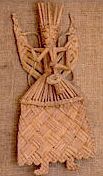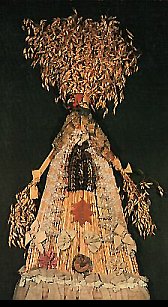 |
|||||
|
|
|||||
|
Now Lammas comes in, our harvest begin,
Corn is a word used to incorporate all types of grain, however the one most commonly used for weaving is wheat, because of its flexible yet durable qualities. Dolly is a corruption of the word "Idol", so Corn Dollies are of course grain idols. Grain has been an essential part of the community since humanity first decided to settle down and grow their own food rather than having to hunt it or gather as they followed the prey. But the crops were fallible. A storm could come at the wrong time, mice could eat the seeded grain, etc. and such a disaster could mean the difference between survival and starvation. So a new culture was built around the cycle of the all-important crops. One of the most important and dangerous times of the year was during the harvest. If the crops were ripe and not yet safely gathered, they were vulnerable to all sorts of natural hazards which occurred according to the whims of the gods. So people did everything they could to assure that the harvest was safe and that the grain would rise again the following year. It has been speculated that a god or spirit of the grain lived in the grain until the grain was harvested and then was released. However, once the god was released, there was no guarantee that it would return. So people may have begun the earliest corn dollies as a form of trapping the god so that it would not be freed, but would continue to grow good crops thus ensuring the survival of the community.
Christina Hole records a ritual associated with this particular design (called "Crying the neck"), however she does not mention the human sacrifice part. It was also recorded in William Hone's Everyday Book published in 1838, and appears to be a custom based around Devon and Cornwall:
Another example from the Cotswolds reports a similar ceremony:
In both cases the sheaf would then be born home (often in its own wagon) sometimes reported as being adorned with flowers and ribbons, and hung there until next planting, when it was returned to the soil. Often the Harvest Home festival was known as the Horkey or Hawky, and the cart bearing the last load of corn, and the Corn Dolly or Harvest Queen was known as the Horkey Cart. In some areas the dolly was ploughed under the soil, in others placed in the centre of the field and blessed, and in others it was fed to the plough horses, and would end up being part of the soil in a slightly more fertile manner! Other Harvest activities closely associate horses and grain. In Herefordshire there is the custom of "Crying the mare" where the image of a horse was made out of a small patch of corn left standing in the field. Sickles were thrown to cut the legs of the "mare"; the winning man was then made the most important person at the subsequent celebration. A similar ceremony, called "Y Gaseg Fedi" was also recorded in Wales. In Suffolk the corn dollies are often made in the shape of horseshoes or whips, as horses were a prominent feature of that county. However they were all supposed to incorporate the corn heads in their design, to fulfil their function as the receptacle for the spirit of the corn. Similarly, the Essex Terret designed to be worn as ornaments on the harness of the horses that drew the carts of reaped corn. In Wales and Scotland there is also customs involving the corn dolly being referred to as a "hag" or "cailleagh" and was regarded as unlucky and fearsome, and awarded to the farmer who was late with his harvest. In Germany it was often referred to as the Old Woman or the Old Man, and the woman who bound the last sheaf was sometimes herself called the Old Woman and it was said to be a good sign that she would marry in the following year. But often it was also awarded to the last farmer to harvest his fields, and it was considered unlucky to be awarded the Old Woman. Perhaps this is where the card game of "Old Maid" originated, where the object of the game is to be the person not left with the Old Maid. The Old Maid is also reflected in the Scottish custom of the "Old Wife". The first farmer to have reaped his field made a doll of some of the corn, the "old wife", which was then sent to the next neighbour etc. until it remained with the last person to harvest his fields, and he had to keep 'the old woman" for that year. On the Island of Lewis, the Old Wife is actually dressed to look as much like an old woman as possible, including sickle, and she is regarded as helping with the harvest. Often the Corn Dollies were regarded as talismans or tokens. A case of one is reported by Christina Hole of a "Kerne Baby" a sheaf dressed in women's clothes, placed near a gate to avert storms. The Corn Dollies were made up to resemble a human figure in many areas, such as the Ivy Girl of Kent. Similar customs from Germany were also recorded in Fraser's The Golden Bough. In some villages of Styria, the dressed sheaf, or Corn-mother, is placed at the top of a pole and paraded around the village. The Corn-mother then presides over the feasting, and later over the threshing. The man unfortunate enough to give the last stroke at threshing is called the "son of the Corn-mother" and is tied up in the Corn-mother and beaten. The grain is then scattered among the young corn and the straw placed with the cattle. In some areas of Scotland the last sheaf of grain was referred to as the Maidhdeanbuain (the shorn Maiden) and the person who gains this can see it as a sign that they will be married in the following year. That person was often then accorded the honour of being the king or queen at the Harvest Home feast:
The sheaf was then plaited and decorated with ribbons and hung in the farmhouse and believed to be a protection against fairies and witchcraft. Some Corn Dolly designs, especially in the Welsh border region, are fringed or ringed and Lambert, in A New Golden Dolly, speculates that this may have been a survival of the Scandinavian sun worship, as straw figures resembling the sun are still made for the Midsummer's Day festivities. Some circular fringed corn dollies have also traditionally been made in Yorkshire. Stack ornaments were the folded and twisted ornaments made at the top of the straw stack and tied with binder twine. They were protective ornaments, generally featuring birds, crosses, crowns etc. The purpose of these were originally supposedly to either stop witches from landing on the stacks during their flights, or else to entertain them so that they wouldn't waste time putting spells on the stack! Later, intricate corn dollies were woven by rural lads when they were courting and given as a token of their favour. In East Anglia, for example, it was the custom that a lad was only allowed to be alone with his sweetheart while he was weaving a corn dolly. Doubtless it was intended to keep his hands chastely occupied, however it did result in some intricate designs being woven! Corn Dollies became a dying art in the time of industrial harvesting, however it was fortunately revived in England in the 1850s. Many of the traditional designs are preserved, being simple plaits and spirals, which may not have changed for thousands of years, and new ones are being developed all the time to incorporate more modern ideas and the cross-cultural pollination of the Twentieth Century.
Use at least two dozen straws with large heads for the core of the dolly and tie tightly just below the heads. Cut the stems to the desired length of the dolly, and tie at the other end. Use another 20-30 smaller stalks for the next section of the core and another 20-30 even smaller for the middle section. These should all be tied onto the original straws, so that the core is tapered at both ends. Evenly tie five straws around the core beneath the heads. Fold the straws outward to form a square, with two straws at one corner of the square. Starting at the corner with the two straws, fold the under straw up and over the straw on the next corner. Turn the core a quarter turn as you work, so that the working straw is brought to the front. Take the new under straw of the corner with two straws and fold it up and over the next corner. Continue in this square design. When the end of the straw is reached, cut the head off a new straw and insert the narrow end inside the hollow end of the working straw. Continue until the end of the core is reached, then continue the same folding and turning. The plait should now produce a braid that can be bent over to form a loop at the top of the dolly. The plaiting straws can then be slotted back through the folds of straw around the dolly, then the ends cut off. A bow of ribbon is generally tied around the heads of the wheat. The traditional colours for the ribbon are as follows: white for purity, blue for the cornflower, red for the sun and the poppy, gold for the Goddess and the grain and green for the rebirth of the seed in the spring. |
|||||
WebDesign: Rhea - Page last updated July 11, 2001
Copyright Shadowplay 2000, 2001. All Rights Reserved.


